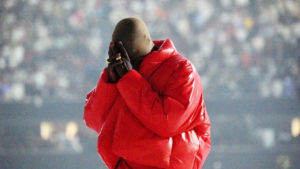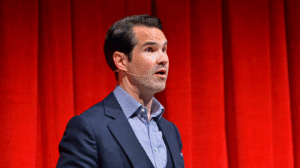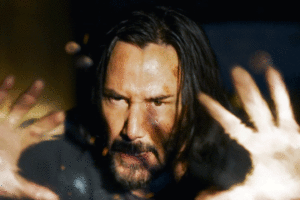“This movie will go back to Batman’s roots,” said the journalist. “Mysterious, brooding, dark, sombre.” “I wanted to make the definitive, dark, serious version of Batman,” said the producer. “We live in very dark times,” said the comic-book writer. “It fits that this would be our hero.”
These quotes all relate to Tim Burton’s 1989 Batman, but similar things have been said about The Batman, the new movie directed by Matt Reeves and starring Robert Pattinson.
“Maybe every ten years Batman has to go through an evolution to keep up with the times,” his co-creator Bob Kane said. But The Batman’s glum rearrangement of old ideas made me wonder if the character is that flexible after all. His arch-enemy, the Joker, is far more fluid, his origins and motives obscure, while the basic facts of Batman are ironclad. Young Bruce Wayne sees his parents gunned down and vows revenge on all criminals. He uses his physical prowess, detective skills and immense wealth to fight crime in the guise of a bat while pretending to be a vapid playboy. Most of his enemies are maniacs.
Something about this outline lends Batman a gritty prestige that other superheroes lack. The Academy’s snubbing of Christopher Nolan’s The Dark Knight in 2009 was so contentious that it led to an expansion of the Best Picture shortlist. Both Heath Ledger and Joaquin Phoenix have won Best Actor for playing the Joker. There is no compulsion to take Superman, Thor or Iron Man seriously — we know they’re not real — but Batman and his enemies have no superpowers and they scrap it out in a gothic nightmare version of New York City, so they have a perceived gravitas that transcends the comic-book genre.
In a recent interview, Pattinson said: “It’s kind of such an insane thing to do: The only way I can live is to dress up as a bat.” Well yes, it would certainly be bizarre if he were real, but he’s not, so I don’t see how his choices are any stranger than, say, Spider-Man’s. This peculiar obsession with pretending that his world is ours hits a wall with The Batman.
Bob Kane lived to see a lot of Batman movies, dying in 1998 at the age of 83. Kane negotiated sole credit for “the Bat-man” but it was his less hard-headed collaborator, Bill Finger, who wrote most of the early stories and made some crucial design decisions: the pointy cowl, the scalloped cape, grey tights instead of red. Batman was a masterpiece of synthesis, jamming together popular tropes from silent movies, radio serials and pulp fiction.
He got his swashbuckling from Zorro, his socialite alter ego from the Shadow, his murdered father from the Phantom, his freakish rogues’ gallery from Dick Tracy and his detective skills from Sherlock Holmes. The result was the saturnine Rolling Stones to Superman’s sunny Beatles. “Superman’s brand of essentially optimistic problem solving found its cynical counterpoint in Batman’s obsessive, impossible quest to punch crime into extinction, one bastard at a time,” says comic-book writer Grant Morrison in Supergods.
During his first year, Batman was a lone vigilante with a gangster-movie disposition. “Much as I hate to take human life, I’m afraid THIS TIME, it’s necessary!” he roared as he machine-gunned two thugs to death. With some newspaper columnists already railing against comic-book violence, editor Whitney Ellsworth soon introduced the first rule of Batman: no guns, no killing. Kane and Finger further softened the character by introducing young Robin, partly to appeal to younger readers and partly to give Batman a Watson-like sidekick to talk to. The “winged figure of vengeance” became a paternal pseudo-cop.
Almost everything we now associate with Batman had been introduced by 1943: Robin, Alfred, Catwoman, the Joker, the Penguin, the Scarecrow, Two-Face, the Batmobile, the Batcave, the Bat-signal, and so on. His origin story (parents, gun, bat) was laid out in just a dozen panels: a classic trauma story decades before that became a cliché. Finger took the name Gotham from a jewellery store in the telephone directory.
The biggest influence on Batman’s post-war evolution outside of DC was a psychiatrist named Frederic Wertham, whose 1954 polemic Seduction of the Innocent brought to a head the moral panic about comic books and juvenile delinquency. Using sketchy anecdotal evidence, Wertham claimed that “the Batman type of story may stimulate children to homosexual fantasies… In these stories there are practically no decent, attractive, successful women… The atmosphere is homosexual and anti-feminine.”
Wertham’s crusade brought the industry to its knees, and the remaining publishers were forced to adopt a stringent Comics Code or die. With anything sinister, sexy or subversive now verboten, Batman writers had to resort to far-out Space Age plots involving aliens, time travel, Bat-Hound and Bat-Mite. Batman himself would routinely be transformed into something ridiculous such as a grey-bearded Rip Van Batman or, most regrettably, Bat-Baby. Batwoman and Bat-Girl were introduced to shore up the hero’s heterosexuality.
DC eventually tried to restore some edge but the goofy spirit of the novelty years fed into the 1966-68 TV series starring Adam West and Burt Ward. Batman was a camp pop art romp (Andy Warhol turned up to the launch party) that I can never quite forgive for licensing sub-editors to use “Kapow!” in the headline of any story about comic books. Apart from turning the Riddler (reimagined in The Batman as John Doe from Se7en with a Gab account) from a subs-bench Joker into a canonical foe, its primary legacy was giving future writers something to repudiate.
After the Batmania bubble popped, DC gave the comic book a hard reboot, aimed at older readers. Writer Denny O’Neil dispatched Robin to college, made Gotham City a gothic hellhole and repositioned the villains as lethal chaos agents rather than crooks with wacky gimmicks. Neal Adams’s cinematic artwork redefined Batman as a brooding spectre who perched on gargoyles, wrapped in an improbably vast cape. “If the script called for a daytime scene, I would simply change it in the artwork to a night-time scene,” Adams said.
Years later, as editor of all the Batman titles, O’Neil drew up the “Bat-Bible” for writers. “The basic story is that he is an obsessed loner,” he explained. “Not crazy, not psychotic… Batman knows who he is and knows what drives him and he chooses not to fight it. He permits his obsession to be the meaning of his life.” Gotham City should feel like New York, specifically “Manhattan below Fourteenth Street at 3 am, November 28 in a cold year”. One challenge to Batman’s pretensions to realism today is that Gotham has never really outgrown the dirty, dangerous New York of Abe Beame and Travis Bickle. “Batman works best in a society that’s gone to hell,” says Frank Miller in the anthology Many More Lives of the Batman. “That’s the only way he’s ever worked.”
Miller arrived in New York from rural Vermont in 1977. Being mugged at knifepoint (twice) gave him a personal incentive to depict vigilantes beating the crap out of criminals in alleyways, and that talent earned him the job of reviving Batman yet again in 1986. In Batman: Year One, a young Bruce Wayne swings into action in a city that’s corrupt to its core. In The Dark Knight Returns, a bitter fifty-something Batman comes out of retirement to become a militarised “god of vengeance” at the helm of a vigilante army. “Is Batman a Fascist?” asked the Village Voice. Miller’s implied answer was: Probably, so what?
Miller was still slamming the Sixties TV show (“For me, Batman was never funny”) but he was kicking a corpse. Two more landmark graphic novels — The Killing Joke by Alan Moore and Brian Bolland, and Arkham Asylum: A Serious House on Serious Earth by Grant Morrison and Dave McKean — cemented Batman as an ultraviolent nocturnal avenger, tormented from within and without. The fans loved it. As Glen Weldon puts it in The Caped Crusade: “Sure, Batman may have been created for children, but Frank Miller and Alan Moore had brought him into the real world, a place of bloody violence and stark sexuality, and now, finally, everybody would see him for the badass the fans had always known him to be.”
Tim Burton brought the gist of this new kitsch-killing Batman to a mainstream audience with his 1989 movie. I’m not sure that Joel Schumacher’s contributions to the franchise, Batman Forever and Batman and Robin, amount to a pendulum swing. He aspired to make “a living comic book”, but the bright, boisterous comics of his childhood memories bore no resemblance to the prevailing Nineties mood of bone-breaking, gun-toting, kick-ass nihilism. A funnier, freakier Batman might have worked but it certainly didn’t in Schumacher’s hands.
After that, Christopher Nolan’s beloved Dark Knight trilogy wasn’t so much a revolution as a restoration, returning Batman to the stygian Gotham of Miller and O’Neil. It is, as Zack Snyder already proved with Batman vs Superman, as hard to follow Nolan as it was easy to improve on Schumacher. The Lego Batman Movie’s brilliant parody of the grim-and-gritty approach now reads as a pre-emptive strike on The Batman: “I don’t talk about feelings, Alfred. I don’t have any, I’ve never seen one. I’m a night-stalking, crime-fighting vigilante, and a heavy metal rapping machine. I don’t feel anything emotionally, except for rage. 24/7, 365, at a million per cent.”
Reeves’s movie feels like a doleful remix of The Dark Knight, incorporating the rain-sodden urban hell of Se7en and the husky, noir voiceover of Rorschach from Watchmen. Pattinson’s Batman says things like, “They think I’m hiding in the shadows — I am the shadows” and, “The city’s angry, scared — like me.” His Bruce Wayne, glum, reclusive and clearly a Nine Inch Nails fan, is no playboy. Nor is he much of a detective, having somehow failed to notice that Gotham’s crooked officials routinely hang out at the nightclub run by the mobsters they’re taking money from.
For all the promotional talk of making this Batman an emo “weirdo”, inspired by Kurt Cobain, the only difference is a matter of degree: he is more withdrawn, more unhappy, more obsessed. Given that his formative psychic wound is the same as it was in 1940, it seems futile to ask again why he is like this. The movie’s politics, such as they are, are as incoherent as Nolan’s in The Dark Knight Rises. Once again, we have an aggrieved underclass whose legitimate gripes with Gotham’s self-serving elite are undermined by all the serial killing and terrorism. So what’s new? What speaks to our particular 2020s anxieties?
There are routes to making Batman interesting again. One would be an off-its-rocker horror movie with an 18 certificate. Another would have a discernible sense of humour and warmth, probably involving Robin. You could even tap into the wild fantasies of DC’s Elseworlds series: Victorian Batman, sci-fi Batman, Twenties Batman, whatever you like this side of Bat-Baby. Just shake the kaleidoscope.
For the 2005 reprint of Batman: Year One, David Mazzuchelli produced a short comic strip about the history of the character and his own role in it. “With Year One, we sought to craft a credible Batman, grounded in a world we recognise,” he wrote. “But, did we go too far? Once a depiction veers toward realism, each new detail releases a torrent of questions that exposes the absurdity at the heart of the genre. The more ‘realistic’ superheroes become, the less believable they are.” Grant Morrison, the writer of Arkham Asylum, recently made a similar point: “Using kids’ adventure heroes to make hackneyed observations about typical human behaviour that does not in fact apply to made up comic book characters strikes me as — I don’t know — whimsical? Dilettantish? A squandering of energy and creativity?”
That memo has yet to reach Hollywood, where poor, sad Bruce remains stuck in a cul-de-sac of scowling trauma and urban decay. If we must have more Batman (and we surely must), then next time let’s make him unreal.
Disclaimer
Some of the posts we share are controversial and we do not necessarily agree with them in the whole extend. Sometimes we agree with the content or part of it but we do not agree with the narration or language. Nevertheless we find them somehow interesting, valuable and/or informative or we share them, because we strongly believe in freedom of speech, free press and journalism. We strongly encourage you to have a critical approach to all the content, do your own research and analysis to build your own opinion.
We would be glad to have your feedback.
Source: UnHerd Read the original article here: https://unherd.com





